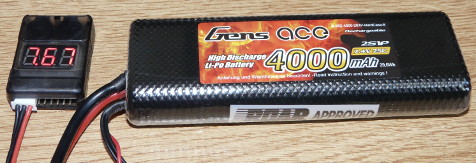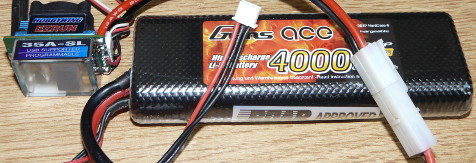LiPo / LiFe batteries: dangers and causes
Before reviewing in detail how to take good care of LiPo / LiFe batteries in order to prevent risks and to safely benefit from their advantages, here are the causes and the dangerous consequences of mis-usage.
 Hits
Hits
Even when they are protected by the chassis frame or a hardcase, you should take great care to avoid any direct hit to the battery pack (dropping the pack, hit by another car especially if the pack is exposed...). Any direct hit compresses the cells (of course, it is worse with softcase packs, but the hardcase is not bulletproof): this pressure will provoke a disruption into the internal cell chemistry leading to permanent damage and causing the cell to puff. This is also why the battery tray needs to leave enough room for the pack: when the battery pack is in use (ie, the model is running), the excitation of the cell internal chemistry makes the cell slightly expand, which is normal. So the battery tray needs to leave room enough for the slight expansion of the battery pack volume. Read more below in the puffing section.
 Tear
Tear
When running, or when you insert or remove the pack from the chassis, sharp pebbles that got into the battery tray may tear the softcase duct. Any alteration of the protective duct dangerously expose the cells: after each run, a battery pack must be thoroughly inspected in order to detect any potential damage, in particular with softcase packs. At your workbench, avoid manipulating sharp tools like knives or scissors close to softcase packs. Read more below in the fire section.
 Short-circuit
Short-circuit
Typically, reverting polarity when plugging the battery pack (in particular those using "banana" plugs). A short-circuit can also happen if the two wires make contact or when one of the wires is disconnected (or loose, or unsoldered). In theory, the battery pack internal circuitry will act as fuse: the battery pack won't be usable anymore, but it will not put you in danger. This is only theory: the immediate alternative to a short-circuit is described below in the fire section.
 Under-sizing the battery pack
Under-sizing the battery pack
This is when you use a low capacity battery pack to power a high-demanding model. This often (but not always and not only) happens with Short-Course models: the motor is often very powerful, the frequent "full throttle and drifting" driving style is very energy-consuming and the truck is heavy (much heavier than any classic 1/10 model): a battery pack without a very high discharge rate (nb of C x capacity in A) will have to provide more voltage than it is capable of. Just a reminder: we saw before that the claimed discharge rates are closer to marketing arguments than to reality. A battery pack working beyond its capacity will permanently puff. Read more below in the puffing section.
 Under-voltage or over-voltage
Under-voltage or over-voltage
When running, the cells in the battery pack do not discharge identically. This lack of synchronism can lead to a cell voltage dropping below its critical voltage value when the other cell(s) in the battery pack keep above the critical voltage value. The only way to avoid this is to correctly set the cut-off function on the ESC or the alarm voltage value. The under-voltage issue can also when a battery pack was stored for a very long time without using the storage mode (read more below in the charger section).
Over-voltage can happen when charging a battery pack without balancing mode. This is why a LiFe or LiPo battery pack must ALWAYS be charged with balancing (read more below in the charger section).
As soon as one cell gets over or under-volted, the cell is destroyed. Read more below in the fire section.
 Puffing
Puffing
It is normal to see a battery pack very slightly expanded right after use (1 or 2mm max). After leaving it at rest for 1 to 2 hours (outside the model), it regains its normal volume. Whenever the puffing is permanent, the battery pack must be considered as no longer usable and dangerous. Indeed, the permanent puffing forces the sealing of the cell membrane that contains the battery polymer: this seal can't eternally resist the puffing, especially because it amplifies after each use.
The permanent puffing can directly be seen on softcase packs. With hardcase packs, it can only be noticed once it is already important enough to alter the hardcase shape, meaning its deterioration state is close to destruction. Read more below in the fire section.
 Fire
Fire
Once a cell membrane gets punctured, either because of a direct tear or because of puffing, a liquid leaks: you only have very few seconds to isolate the battery pack by placing it on a non-inflammable surface (in the fireproof lipo-safe bag, on tiled-floor, in a sink, on sand...).
As for LiFe batteries, gas will leak (unknown toxicity, certainly not healthy), but there is no risk of fire.
As for LiPo batteries, the oxygen in the ambient air will ignite a violent reaction leading to an "explosion" (like Bengal light): you can find many videos on internet showing this. Anyway, except if you have the specific relevant fire extinguisher ready at hand, the fire will last as long as there are chemical components left to burn inside the pack. If the pack is on or close to anything flammable, the fire will immediately spread (the model if the pack was still inside, appartment, house...).
Using a lithium battery
Now that we reviewed the causes of misuse and their dangerous consequences, let's see how to take good care of batteries in order to use them safely.
As we saw previously, a LiFe or LiPo battery pack needs to be wedged into the chassis battery tray : this reduces any potential friction on pebbles that could damage the external pack protection and avoids the pack to continuously hit the battery stay walls. However, the chassis battery stay should still have room enough to properly bed the pack so it can expand a little bit while in use. So the best is a 1 to 2mm clearance all around the pack. If needed, you can use foam inserts to better hold the pack into the tray.
To safely use a LiFe or LiPo battery in a model, you necessarily have to respect one of these 2 wiring methods:
With Low Voltage Alarm

Using the built-in ESC cut-off

On the first photo, the battery pack is connected to the ESC as normal, but also to an external low voltage alarm through the balance lead: electronics integrated to every LiFe or LiPo battery pack provide information on each cell voltage through this lead. The external alarm reads this information and beeps whenever the voltage of any cell drops down to the preset value that was setup on the alarm (if this setup is available: by default, it is set at 3.3v for LiPo alarms. For LiFe, you need to use and setup a Cell Checker to the correct value).
On the second photo, the pack is connected to the ESC as normal and the ESC monitors the pack voltage. Yes, I did write the ESC monitors the battery pack voltage, not each cell voltage, unlike any external alarm device. Unless I am mistaken, an ESC only monitors the overall battery pack voltage, despite what you may think when programming the "cell cut-off" value on ESCs.
In concrete, here are the cut-off values per cell to setup in ESCs and external alarm devices (when available). Caution, when using Tamiya ESCs, the preset value is only for LiFe batteries (and you can't change it):
- LiFe cut-off: 3.0V / cell (recommended value because the voltage per cell brutally drops at 3.0V)
- LiPo cut-off: 3.3V / cell
You don't need to set higher cut-off values: the critical value for a LiFe cell is 2.5V (but, again, the voltage drops dramatically fast as soon as it reaches 3.0v) and 3.0V for a LiPo cell. Considering the cut-off or alarm reacts as soon as the value is reached (which means a current peak drain) and because the voltage raises back a little after high current drains, the real voltage after the cut-off or alarm should remain at about 0.1 to 0.2V above the preset value.
Anyway, as soon as the cut-off function slows down the vehicle or the alarm screams, you must ALWAY IMMEDIATELY stop the vehicle, then switch it off and disconnect the battery pack (as there is always a remaining current drop with ESCs, even when switched off).
OK, let's focus a moment on the ESC monitoring over the global battery pack voltage instead of a monitoring per cell: even though this is not the most precise monitoring, it is reliable and safe. In fact, despite the discharge not being balanced between cells, the difference almost never reaches 0.3V between cells. This difference is the security margin between the cut-off value and the critical low voltage value per cell, and again, the cut-off is activated by high power drains. However, in practice, this reliable and safe method applies when using good quality elements, that is both the ESC monitoring precision and the cell quality of the battery pack.
The advantage for using the ESC cut-off function is simplicity (once the ESC is correctly setup). The drawback with external devices is to add an extra part to place into the chassis. Anyway, you also can use both solutions at the same time..




